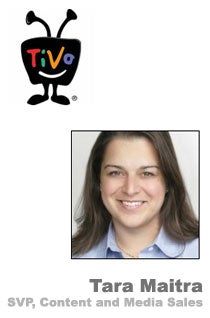 Over the past several years, TiVo has looked to find ad tech alliances to put its extensive data to use in attracting marketers looking to access its deep information on households via the set-top box. The latest partnership (see release) represents an extension of its work with Simulmedia, one of the earlier companies to make a bet that online media methods of audience targeting can be made to work on TV.
Over the past several years, TiVo has looked to find ad tech alliances to put its extensive data to use in attracting marketers looking to access its deep information on households via the set-top box. The latest partnership (see release) represents an extension of its work with Simulmedia, one of the earlier companies to make a bet that online media methods of audience targeting can be made to work on TV.
“With our second by second viewing behavior from across the nation, TiVo data plays an important role in shaping the TV advertising landscape,” says Tara Maitra, TiVo’s SVP for Content and Media Sales, explaining the DVR’s value proposition to marketers and ad tech companies like Simulmedia, as well as existing partners AT&T U-Verse and TV audience analysis firm TRA.
Simulmedia CEO Dave Morgan also highlighted why TiVo is so coveted by ad tech firms. “We injest data from 30 million Americans every a day, anonymously and TiVo is most important data set of all,” said, aware of the DVR provider’s data cover 2 million homes.
TiVo has been selective, yet open about who it partners with. For example, in a sign of goodwill last February, TiVo buried the hatchet with AT&T following a $215 million legal settlement between over DVR patents and entered into a licensing agreement to share and collect audience data covering the AT&T U-Verse IPTV system.
Years ago, when ad agencies and TV networks had regarded the DVR as a threat that would make it all too easy for viewers to skip commercials, while time-shifted viewing would erode the value of primetime schedules altogether. TiVo responded to those fears with its Showcase product, which encouraged ad agencies and marketers as partners, while TiVo also calmed networks by providing more data about the shows being watched.
As such, it’s data is widely in demand from ad agencies and tech firms trying to tap into the $70 billion TV ad market. After all, online advertising is tremendously effective in targeting, but in terms of the ability to “tell a story” and drive brand awareness and affinity, TV is still generations ahead of the web, Morgan noted.
“TV advertising is extraordinarily effective: when you hit the person, you get a result — it’s very impactful to be able to call upon sight, sound and motion on behalf of a marketer’s message. But when you can track delivery of every TV ad, you realize it has even greater impact.”
The idea is that even with TV’s capacity to move consumers, fragmentation and the need for greater ROI is driving the need for better data.
“We estimate that about 75 percent of TV ads are unnecessary wasted,” Morgan said. “Using data like TiVo’s will help reduce that waste.”
By David Kaplan











